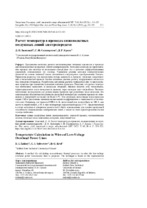Расчет температур в проводах низковольтных воздушных линий электропередачи

Date
2025Publisher
Another Title
Temperature Calculation in Wires of Low-Voltage Overhead Power Lines
Bibliographic entry
Зализный, Д. И. Расчет температур в проводах низковольтных воздушных линий электропередачи = Temperature Calculation in Wires of Low-Voltage Overhead Power Lines / Д. И. Зализный, Г. И. Селиверстов, Д. Г. Кроль // Известия высших учебных заведений и энергетических объединений СНГ. Энергетика. – 2025. – № 4. – С. 311-323.
Abstract
Предложена методика расчета нестационарных тепловых процессов в проводах для низковольтных воздушных линий электропередачи. Методика основана на представлении провода как системы из нескольких однородных тел и решении дифференциальных уравнений, описывающих эту систему. Уравнения решены методом электротепловых аналогий на основе тепловой схемы замещения и операторного преобразования Лапласа. Приведены формулы для определения потерь мощности в проводе, тепловых сопротивлений и теплоемкостей провода. Особое внимание уделено расчету коэффициента теплоотдачи с поверхности провода. Разработаны алгоритмы расчета температур одно- и многожильных проводов при изменении влияющих внешних факторов. Показано, что расчет температур необходимо выполнять за несколько итераций. Введено понятие угла теплообмена, характеризующего часть поверхности провода, через которую идет теплообмен. Экспериментальные исследования для разных марок проводов при различных токах показали, что максимальная абсолютная погрешность расчетной температуры изоляции провода по отношению к измеренной составляет не более 6 °С. Для длительно допустимых токов проводов марки СИП-4 рассчитаны значения понижающих коэффициентов в зависимости от количества жил. Например, для провода СИП-4 4´16 допустимый ток должен быть не 100 А, как дается в справочниках, а 80 А при температуре окружающей среды 25 °С. Представленные в статье методики и алгоритмы расчета могут быть использованы для оценки пропускной способности низковольтных электрических сетей, а также на этапе проектирования систем электроснабжения.
Abstract in another language
A method for calculating non-stationary thermal processes in wires for low-voltage overhead power transmission lines is proposed. The technique is based on the representation of a wire as a system of several homogeneous bodies and the solution of differential equations describing this system. The equations are solved by the method of electrothermal analogies based on the thermal substitution circuit and the Laplace operator transformation. Formulas are given for determining the power losses in the wire, thermal resistances and heat capacities of the wire. Special attention is paid to calculating the coefficient of heat transfer from the surface of the wire. Algorithms for calculating the temperatures of single-core and multi-core wires when influencing external factors change have been developed. It is shown that the temperature calculation must be performed in several iterations. The concept of heat exchange angle is introduced, characterizing the part of the wire surface through which heat exchange takes place. Experimental studies for different brands of wires at different currents have shown that the maximum absolute error of the calculated insulation temperature of the wire relative to the measured temperature is no more than 6 °C. For the long-term allowable currents in the wires of the SIP-4 brand (‘self-supporting insulated wires’), the values of the reduction coefficients are calculated depending on the number of cores. For example, for the SIP-4 4x16 wire, the permissible current should not be 100 A, as given in the directories, but 80 A at an ambient temperature of 25 °C. The calculation methods and algorithms presented in the article can be used to estimate the capacity of low-voltage electric networks, as well as at the design stage of power supply systems.
View/
Collections
- № 4[6]
